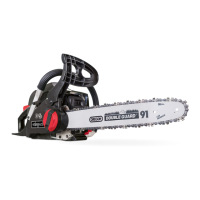www.scheppach.com / service@scheppach.com / +(49)-08223-4002-99 / +(49)-08223-4002-58
48
|
GB
m WARNING
The chain brake does reduce the risk of injury in the
event of a kickback but cannot provide the intend-
ed protection if the saw is used carelessly. Always
check the chain brake before using your saw and
check regularly when working. (For details on per-
forming a test on the mechanical brake, see below).
4. TESTING THE CHAIN BRAKE
• The chain brake is RELEASED (the chain can
move) when the BRAKE LEVER (5) IS PULLED
BACKWARDS (g. 11 / item 2) AND APPLIED as
shown in g. 11.
• The chain brake is APPLIED (the chain is locked)
when the brake lever (5) is pulled forwards and vis-
ible in the mechanism (shown in g. 10). The chain
should then not be able to move (g. 30).
m WARNING
The brake lever should engage in both positions. If
you feel a strong resistance or the lever cannot be
moved, do not use your saw. Take it to a professional
service centre for repair immediately.
5. FUEL AND OIL - RECOMMENDED FUELS
For optimal results, use normal unleaded fuel blend-
ed with special 2-stroke oil. Prepare the mixture as
specied in the fuel mixing table.
m CAUTION
Do not use a fuel mixture that has been stored for
longer than 90 days.
m CAUTION
Do not use 2-stroke oil product with a mixing ratio of
100:1. Insucient oil will damage the engine and, in
this case, void the warranty for the motor.
m CAUTION
Only use containers designed and approved for
transporting and storing fuels. Fill the correct quan-
tities of petrol and 2-stroke oil into the mixing con-
tainer supplied (see the scale printed on the contain-
er). Then sake the container well.
Some conventional gasolines are blended with ingre-
dients such as alcohol or ether compounds to meet
the standards for clean exhaust gases. The engine
runs satisfactorily with all grades of gasoline, but for
the purpose of self-propulsion with oxygenated gas-
olines, it is best to use regular gasoline. At best, use
regular unleaded gasoline.
• Keep the bar’s tip pointing upwards and turn the
chain tensioning wheel (g. 9 / item 3) CLOCK-
WISE to increase the chain’s tension. If you turn
the chain tensioning wheel ANTICLOCKWISE, the
chain tension is reduced. Ensure that the chain is
tight around the bar (g. 4 / item X3).
• After making the adjustments, tighten the chain
tensioning wheel while the bar’s tip is pointing up-
wards (g. 9 / item 18). The chain is tensioned cor-
rectly if it is tight and can be pulled around the bar
when the chain brake (5) is released.
m WARNING
Always wear high strength gloves when handling the
saw chain or adjusting it.
m If the chain can moves around the bar with dicul-
ty or is blocked, it is tensioned too tightly. Perform the
following ne adjustments:
A Loosen the bar fastening wheel (g. 9 / item 18) by
turning 1/2 a turn ANTICLOCKWISE. Then reduce
the chain tension by turning the chain tensioning
wheel slowly (g. 9 / item 3) ANTICLOCKWISE
and then pull the chain forwards and backwards
on the bar (g. 30). Continue this procedure until
the chain can move freely but is still tight (g. 4 /
item X2). Increase the chain tension by turning the
chain tensioning wheel CLOCKWISE.
B When the saw chain tension is adjusted correct-
ly, hold the bar with the tip pointing upwards and
tighten the bar fastening wheel (g. 9 / item 18).
m A new saw chain stretches so that it has to be
re-adjusted after around 5 sawing procedures. This
is normal for new saw chains and the interval for fu-
ture adjustments increases after a short time.
m If the saw chain is tensioned TOO LOOSE or TOO
TIGHT, the drive wheel, the bar, the chain and the
crankshaft bearing wear out quicker. Fig. 4 / item X2
shows the correct tension (when cold) and g. 4 /
item X3 shows the tension (when cold). Fig. 4 / item
X1 shows a chain that is too loose.
3. MECHANICAL TEST OF THE CHAIN BRAKE
Your chainsaw is equipped with a chain brake that
reduces the risk of injury due to a kickback. The
brake is activated if pressure is exerted on the brake
lever as soon as the operator’s hand hits the lever,
e.g. during a kickback. If the brake is activated, the
chain stops abruptly.

